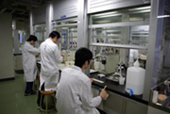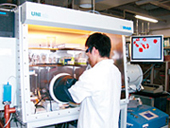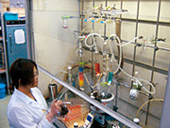Reserach
Introduction
Chemistry is a science that treats the structure, synthesis, and properties of substances, particularly at the molecular level. We are surrounded by chemical products: food, clothing, housing materials, drugs, etc. New materials, such as those that support computer memory storage and superconductivity, have played an essential role in recent technological and cultural progress. Some chemicals, on the other hand, give rise to serious environmental problems, the solutions to which problems depend upon chemistry research and education. Thus, chemistry and related sciences are much closer to our everyday lives than we might imagine, and they contribute significantly to the development of science and human society.
The Department of Chemistry, Graduate School of Science at Osaka University, comprises the following four divisions: Inorganic, Physical, Organic, and Interdisciplinary chemistries. In addition, the department has established collaborations with thirteen research groups in other research institutes.
Inorganic Chemistry Division
The Analytical Chemistry, Inorganic Chemistry, Coordination Chemistry, and Radiochemistry Laboratories are included in this division.
The Analytical Chemistry Laboratory investigates the nanochemistry of liquid?liquid interfaces to elucidate the specific role of the interfaces in chemical processes. The diffusion dynamics of single molecules and the reaction mechanism for the formation of chiral molecular aggregates at liquid-liquid interfaces are investigated in terms of the mechanisms for solvent extraction and bio-membrane reactions. New principles governing the separation and analysis of biological microparticles are developed through the applications of forces generated by lasers, electric fields, and magnetic fields.
The main goals of both the Inorganic and Coordination Chemistry Laboratories center on the exploration of novel transition metal complexes that show unique structures and properties. New types of mononuclear and polynuclear metal complexes have been synthesized, and the relationship between their structures and chemical properties is elucidated in solid and solution phase by electronic spectroscopy, NMR, X-ray diffraction studies, and magnetic measurements. New spectroscopic techniques that involve application of magnetic fields, and specific chiral recognition abilities of metal complexes, are also investigated.
In the Radiochemistry Laboratory, superheavy elements and actinide nuclei are synthesized, and their chemical properties are studied using several novel techniques. The chemistries of a new artificial atom composed of a pion and a muon, called an exotic atom, are investigated in this laboratory. The nuclear reaction mechanisms of these heavy ions and the identification of new nuclear phenomena, together with their application to physical and chemical research, are also of interest.
Physical Chemistry Division
Research and educational activities in the Physical Chemistry Division cover experimental studies of the structure, properties, and reactivity of molecules and condensed matter and their theoretical analysis.
In the Condensed Matter Physical Chemistry Group, the electronic properties of molecular conductors, molecular magnets, metal complexes, and their network magnetic systems are studied by calorimetry, transport, and magnetic measurements. Novel features that originate from the cooperative effects of spin, charge, and molecular motions are discussed.
The Surface Chemistry Group is concerned with the electronic properties of molecules adsorbed on solid surfaces, characterized by femtosecond laser and electron spectroscopies. Micro-spot two-photon photoemission spectroscopy has been developed to probe unoccupied states in energy, time, and spatial domains. The Reaction Dynamics Group investigates gas-phase and surface chemical reactions at the molecular level from the perspective of stereodynamics. A novel combination of techniques that uses hexapole fields and molecular beams enables the orientation of reactant molecules to achieve control in chemical reactions.
The primary focus of the Biophysical Chemistry Group is the development and use of laser-based techniques to measure atomic-level features of biological systems. The results of these efforts contribute to a deeper understanding of the nature of protein motions and the relationship between molecular-level dynamics and biological function.
The Quantum and Theoretical Chemistry Group employs computational and theoretical analysis techniques to predict the properties and reactivities of chemical substances, and to assist in the design of functional materials. New computational methodologies are also developed in this group.
The Research Center for Structural Thermodynamics is devoted specifically to the chemical thermodynamics of various types of condensed matter, including hard materials, such as high-TC superconductors, soft materials, such as liquid crystals, and rather complex systems, such as adsorbed monolayers. We are particularly interested in the order and disorder created by the subtle balance between the various intermolecular interactions.
The physical chemistry group at the Museum of Osaka University investigates the structure and dynamics of molecules confined in the nanospaces formed within solid state materials, using high-resolution solid-state NMR and ESR techniques along with other physicochemical measurements. The goal is to develop non-destructive examination methods of physical chemistry for historical materials in Osaka University.
Organic Chemistry Division
In the Division of Organic Chemistry, we observe natural phenomena through the structural and chemical behavior of organic molecules, and we investigate the underlying principles that operate in live systems. We extend knowledge through theoretical considerations of the structures and properties of molecules and molecular interactions. These efforts permit interpretation of sophisticated natural systems and enable the design and synthesis of functionally interesting organic compounds. The Division of Organic Chemistry consists of the following four independent research groups.
Research in the Laboratory for Physical Organic Chemistry is directed toward the molecular design and synthesis of artificial novel compounds with theoretical and functional interest, particularly with electric or photinic properties. Such efforts are directed toward the goal of realizing self-organized single molecular electronics. Major research projects in the Laboratory for Structural Organic Chemistry are related to the synthesis of novel extended π-electron systems and artificial supramolecules. New synthetic procedures for molecules with conjugated electronic systems are also investigated. Systematic studies of these synthetic compounds enable discovery of novel classes of functionally interesting and versatile compounds.
The Laboratory for Natural Products Chemistry focuses on the functions of glycoconjugates that consist of carbohydrates linked to other structural units, such as fatty acids and phosphates. Unknown bioactive compounds from natural sources are isolated, and their structures, total synthesis, and functions are intensively studied.
The purpose of research in the Laboratory for Organic Biochemistry is to clarify the functions of oligosaccharides in living mammalian as well as plant cells. Glycoproteins, glycopeptides, and oligosaccharides are chemically synthesized for use in bioassays that elucidate oligosaccharide functions. Several new reactions for the construction of such bimolecules are also studied.
Interdisciplinary Chemistry Division
In the Interdisciplinary Chemistry Division, research is oriented toward novel fields in both bioorganic and bioinorganic chemistry.
Marine toxins and other biologically active compounds, such as hormones, are investigated in the Laboratory for Biomolecular Chemistry. New methodologies based mainly on NMR spectroscopy are being developed for the investigation of three-dimensional conformations and functions of complex biomolecules.
Research projects in the Laboratory for Bioinorganic Chemistry are directed toward the relationship between structure and function in metalloproteins and toward the synthesis of transition metal complexes as active site models. Model complexes are structurally and functionally compared to the properties of the active sites of proteins.

Experiment in inorganic chemistry

Single Crystal growth of exotic organic
functional materials under the oxygen-free condition
(< 5 ppm O2)

Synthetic organic experiment
using exhaust equipment for safety
